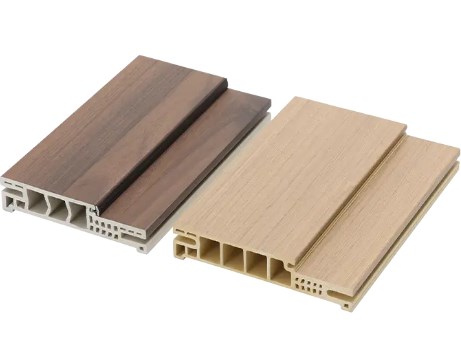In modern architectural decoration, WPC decorative materials are gaining increasing attention due to their superior performance and environmental friendliness. WPC, or Wood Plastic Composite, is a composite material made primarily from wood fiber or wood powder, combined with high-molecular polymers through a specialized process. Compared to traditional wood and plastic, WPC decorative materials offer significant advantages in terms of moisture resistance, corrosion resistance, wear resistance, and aesthetics, making them a popular choice for interior and exterior decoration.
Structural Characteristics of WPC Decorative Materials
The core of WPC decorative materials lies in their unique composite structure. The wood fibers provide natural texture and structural support, giving the material excellent rigidity and tactile feel; while the plastic component imparts excellent weather resistance and corrosion resistance. This structure prevents WPC from deforming or cracking in humid environments, while maintaining a natural wood-like texture. During the production process, modern WPC decorative materials utilize reinforcing agents and surface treatment techniques to further enhance wear resistance and color stability, ensuring they maintain their outstanding visual effects over long-term use.
Performance Advantages of WPC Decorative Materials
In terms of performance, WPC decorative materials combine the advantages of both wood and plastic. First, its waterproof properties significantly surpass those of natural wood, making it widely suitable for use in moisture-prone environments such as outdoor patios, balconies, and pool surrounds. Second, WPC is corrosion-resistant and insect-resistant, resisting termites and other pests. It offers low maintenance and a long service life. Furthermore, WPC offers excellent processability, allowing for complex designs through cutting, drilling, and splicing, providing greater creative possibilities for decorative design. WPC's excellent anti-slip and sound-absorbing properties make it an excellent choice for floor and wall decoration.
Environmental Protection and Sustainable Development
With the growing popularity of environmental protection, the sustainability of WPC decorative materials has become a key selling point. WPC materials are typically made from renewable wood fiber and recycled plastic, reducing reliance on natural forest resources and lowering the environmental burden. Modern manufacturing processes emphasize low energy consumption and emissions, meeting green building material standards. At the end of their lifecycle, WPC can be recycled and reprocessed, achieving resource recycling and embodying the concept of green development. This makes WPC decorative materials promising for applications in modern eco-friendly buildings and green homes.

Diverse Decorative Applications
WPC decorative materials are widely used in both indoor and outdoor decoration due to their durability and aesthetics. Outdoors, WPC is commonly used in balcony flooring, garden walkways, guardrails, and outdoor furniture, withstanding weather and weathering without aging. Indoors, WPC is widely used in wall coverings, ceilings, partitions, and flooring, where its natural texture and rich colors add warmth and texture to any space. With the advancement of material technology, WPC surface textures and colors are becoming increasingly diverse, catering to diverse design styles, from modern minimalist to classic retro, seamlessly blending in with the overall decor.
Market Trends in WPC Decorative Materials
In recent years, the WPC decorative materials market has shown steady growth. With increasing demand for environmentally friendly, durable, and aesthetically pleasing decorative materials, the application areas of WPC materials have continued to expand. Acceptance of WPC materials in industries such as construction, home improvement, and landscape design is gradually increasing. At the same time, manufacturers are continuously innovating in material modification, surface treatment, and process optimization, driving the development of WPC decorative materials towards high-end and customized designs. With the advancement of green building standards and environmental policies, the application prospects of WPC decorative materials in residential, commercial, and public spaces will be even broader.
With its superior performance, environmental friendliness, and diverse decorative effects, WPC decorative materials are gradually replacing traditional wood and plastic materials and becoming a key choice for modern architectural decoration. Their unique composite structure provides excellent weather resistance and aesthetics, while also emphasizing environmental protection and sustainable development, making them highly competitive in the interior and exterior decoration market. With continuous technological advancements and growing market demand, WPC decorative materials are poised to play an even more important role in the future decoration market, offering greater possibilities for architectural and home design.
Recommended News